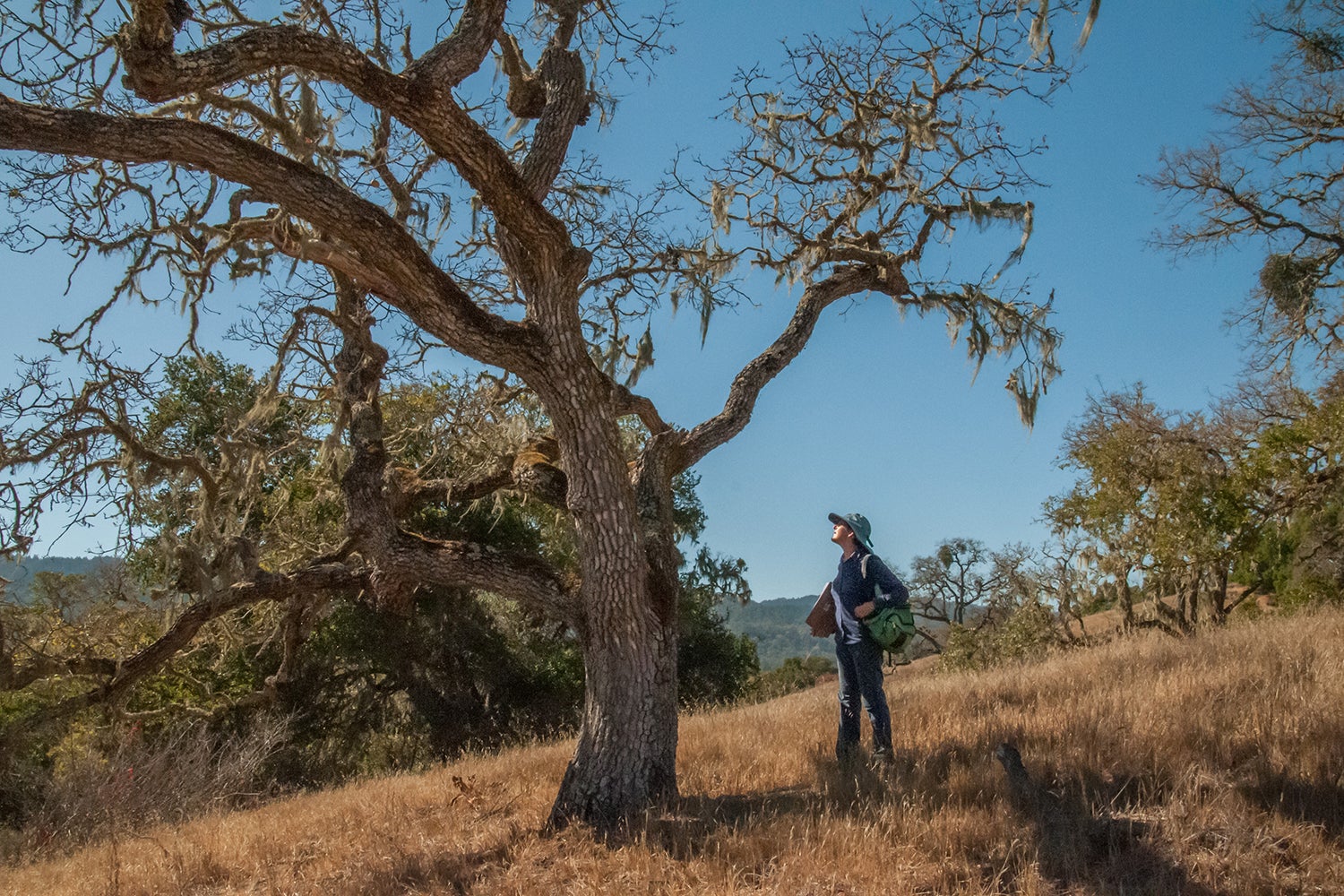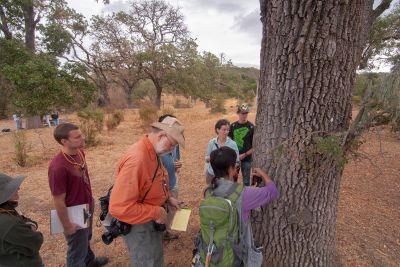In 1993, Stanford University biology professor Deborah Gordon and her first graduate student, Katy Human, began a survey of ants at Stanford’s Jasper Ridge Biological Preserve. Nearly 30 years, four more graduate students and scores of volunteers later, that survey continues on – and has recently yielded a surprising result.

Stanford biology professor Deborah Gordon at a valley oak covered in lace lichen. According to photographer and Jasper Ridge docent Dan Quinn, she had found a trail of winter ants in the tree. (Image credit: Dan Quinn)
“From 1993 until the time I was doing my dissertation work, about 2000, it seemed as if Argentine ants were marching across the preserve, taking out native ants along the way,” said Nate Sanders, one of Gordon’s former graduate students who led the survey in the late ’90s and is now a professor of ecology and evolutionary biology at the University of Michigan. “Now, with an additional 20 years of data, we see the story is more complex.”
That additional data, detailed in a paper published Aug. 3 in Ecology, has revealed that the distribution of Argentine ants in Jasper Ridge has actually receded, and further analysis suggested that climate change was a significant factor in this change. The researchers also found that, over the span of the survey, overall native ant diversity increased and some native ant species have expanded their distributions.
However, the researchers caution against making this an optimistic story about the effects of climate change, which still overwhelmingly poses severe threats to native species. But their work does stand as a testament to the importance of long-term research and what it takes to produce that work.
“To keep this survey going, there have been over a hundred participants over the years,” said Lisa Couper, the latest Stanford graduate student to study the survey and lead author of the paper. “Long-term ecological datasets are really rare and, as far as we know, this is one of the longest-running surveys of an ongoing biological invasion.”
Ecology’s ‘movers and shakers’
Focusing on insects, as opposed to larger subjects like birds or mammals, allows researchers to explore the vital mechanisms of ecosystems on a small scale. Ants, in particular, offer insights into many aspects of the natural world due to the many roles they play in their environments.
“For many years I’ve referred to ants as ecology’s movers and shakers,” said Sanders, who is a co-author of the paper. “So almost anything you can think of that an organism does in nature, ants do it and have been doing it for millions of years.”

Image credit: Dan Quinn

Image credit: Dan Quinn

Image credit: Dan Quinn

Image credit: Dan Quinn

Image credit: Dan Quinn

Image credit: Dan Quinn

Image credit: Dan Quinn

Image credit: Dan Quinn
The many duties performed by ants include altering the flow of nutrients and ecosystems, pollinating, dispersing seeds, engaging in mutually beneficial relationships with other organisms and acting as predators. So, any disruption of ant populations can have a pervasive effect.
“A rich community of ants, with many different types coexisting, will function differently than a community dominated by only one ant species,” said paper co-author Nicole Heller, another former graduate student and ant survey leader who is now associate curator of anthropocene studies at the Carnegie Museum of Natural History. “When we lose biodiversity, some of the beauty and resilience of a place is lost too.”
To monitor the ants of Jasper Ridge, the survey has covered an average of 288 sites twice a year. Surveyors go to their assigned locations, look for ants within 20 meters and record the species they see. (They don’t count the ants but are instead focused on the distribution of different species in the preserve.) In 2010, the Gordon lab turned control of the survey over to Jasper Ridge and it became a citizen science project. [People interested in volunteering for the survey can contact the volunteer coordinators.]
Exciting confirmation
Among the survey’s findings: The area occupied by Argentine ants shrank by 30 percent and 27 percent from 1994 to 2020 in fall and spring surveys, respectively. But the distribution of winter ants – a native species – expanded 70 percent during this time period in the spring surveys. Distributions of two other native ant species declined over the 28 years in at least one season, and another two stayed the same.
To better understand why species distributions were changing, the researchers analyzed the survey data using a structural equation model, which is a method for assessing direct and indirect effects of different environmental factors. For example, they were able to look at how climate directly affects the distribution of Argentine ants and how it directly affects the distributions of native ants and also how climate indirectly affects the Argentine ants via its effect on the native ants.
“I think structural equation modeling can be especially useful in ecology because it allows you to incorporate expert knowledge about a system in the way you set up the relationships,” said Couper.
The reduced distribution of Argentine ants followed an extreme drought that occurred from 2012 to 2015 and the researchers’ analysis determined that reduction was directly related to climate change – specifically, changes in precipitation and in summer maximum temperatures. They also found some evidence for how climate indirectly effects Argentine ants through its effects on native ants.
“I’ve been looking at the data and I suspected this was happening, but I thought it was too good to be true. It took this analysis to really confirm what we saw,” said Gordon, who is a professor of biology in the School of Humanities and Sciences and senior author of the paper. “It has been gratifying to see the winter ants push back against the Argentine ants.”
A long story
Argentine ants seek out water in residential areas, so droughts reduce that resource for them doubly by reducing both natural sources of water and human-made sources.
“The fact that the common native ants were not as influenced by the extreme drought suggests that the California ants have behavioral strategies that are adapted to a greater range of variation in climate,” Heller said. “That is a good thing for the resilience of the local ant community and for regional biodiversity.”
That being said, just as each era of this survey tells a very different story about invasion, the researchers stress that there is no knowing how future – and more severe – droughts and other climate change consequences, such as wildfires, will affect these species. Fortunately, the Jasper Ridge ant survey will be part of that future as well.
“It’s been a project that so many different groups of people at Stanford have been involved with – undergrads, grad students, some of whom are still collaborating on this years later, people from the community,” said Gordon. “It’s been really great that this one project has pulled in so many different kinds of people and kept us connected. We welcome new volunteers.”
Gordon is also a member of Stanford Bio-X and the Wu Tsai Neurosciences Institute, and an affiliate of the Stanford Woods Institute for the Environment.
The researchers emphasize that this work benefited immensely from the dozens of Jasper Ridge ant survey volunteers over the years and they give special thanks to Merav Vonshak, Matt Bahls and Angie Nakano, and to Philippe Cohen for his help initiating the citizen science project when he was director of Jasper Ridge. The research was supported by Jasper Ridge Biological Preserve and the Stanford School of Humanities and Sciences.
To read all stories about Stanford science, subscribe to the biweekly Stanford Science Digest.
Media Contacts
Taylor Kubota, Stanford News Service: (650) 724-7707, tkubota@stanford.edu